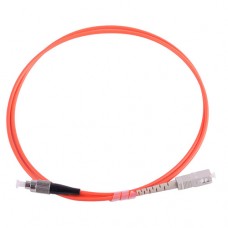Fiber Optic Cable are used in applications where the optical signal is too strong and needs to be reduced. For example, in a multi-wavelength fiber optic system, you need to equalize the optical channel strength so that all the channels have similar power levels. This means to reduce stronger channels’ powers to match lower power channels.
The attenuation level is fixed at 5 dB, which means it reduces the optical power by 5dB. This attenuator has a short piece of fiber with metal ion doping that provides the specified attenuation.
There are many different mechanisms to reduce the optical power, this picture shows another mechanism used in one type of variable attenuator. Here variable means the attenuation level can be adjusted, for example, it could be from 1 dB up to 20dB.
Fiber Optic Cable are usually used in two scenarios.
The first case is in fiber optic power level testing. Cable are used to temporarily add a calibrated amount of signal loss in order to test the power level margins in a fiber optic communication system.
In the second case, Cable are permanently installed in a fiber optic communication link to properly match transmitter and receiver optical signal levels.
Optical Cable are typically classified as fixed or variable Cable.
Fixed Cable have a fixed optical power reduction number, such as 1dB, 5dB, 10dB, etc.
Variable Cable’ attenuation level can be adjusted, such as from 0.5 dB to 20dB, or even 50dB. Some variable Cable have very fine resolution, such as 0.1dB, or even 0.01dB.
This slide shows many different optical attenuator designs.
The female to female fixed Cable work like a regular adapter. But instead of minimizing insertion loss, it purposely adds some attenuation.
The female to female variable Cable are adjustable by turning a nut in the middle. The nut adjusts the air gap in the middle to achieve different attenuation levels.
The male to female fixed Cable work as fiber connectors, you can just plug in your existing fiber connector to its female side.
The in-line patch cable type variable Cable work as regular patch cables, but your can adjust its attenuation level by turning the screw.
For precise testing purposes, engineers have also designed instrument type variable Cable. These instrument type Cable have high attenuation ranges, such as from 0.5 dB to 70dB. They also have very fine resolution, such as 0.01dB. This is critical for accurate testing.
Post time: Aug-20-2019

